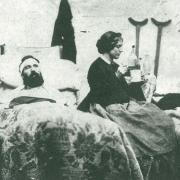Chief Camp Diseases of the Civil War
[[{"type":"media", "view_mode":"media_large", "fid":"812", "attributes":{"class":"media-image aligncenter wp-image-1160", "typeof":"foaf:Image", "style":"", "width":"514", "height":"320", "alt":"Union Nurse Annie Bell in Nashville"}}]]My novel Wedded to War explores the medical care of the Union army during that first chaotic year of the Civil War. During this time, disease was more of a killer than injury, especially in the Army of the Potomac during their ill-fated Peninsula Campaign in the marshes and swamps south of Richmond, Virginia.
Below are a few of the most prominent diseases that affected troops even before they could shoulder their rifles in battle. This information can be found in many sources, including the National Museum of Civil War Medicine (www.civilwarmed.org) in Frederick, Maryland, which I visited as part of my research for this novel. The statistics for the Confederate side were not tracked as well. (Other sources will be listed at the end of this post.) Diarrhea and Dysentery The terms diarrhea and dysentery were often used interchangeably, but both were widespread and seriously debilitating. (Some sources say General Robert E. Lee was suffering with it during the Battle of Gettysburg in 1863, and that it affected his decision-making ability.) On the Union side, there were at least 1.6 million cases with more than 27,000 deaths during the course of the war. Causes ranged from poor diet and cooking practices (called at the time “death by frying pan”) to infection with microscopic organisms. For unknown reasons, chronic diarrhea and dysentery sometimes persisted for the remainder of a soldier’s life. Treatment included a good diet of fresh fruits and vegetables, opiates in alcohol and sometimes oil of turpentine and glycerin. Malaria Malaria is a fever-inducing disease caused by microscopic parasites transmitted to humans by the bite of the Anopheles mosquito—but no one knew this during the Civil War. The cause was thought to be “swamp miasma,” an invisible agent which floated through the air. Nearly a million cases of malaria were reported in Union records, with approximately 4,800 deaths. The disease was most common among soldiers of both sides serving in the deep South. Quinine, as the powdered bark of the cinchona tree or as quinine sulfate derived from the bark, served as an effective preventative and cure. Nutritional Diseases The major nutritional diseases seen during the war were scurvy (vitamin C deficiency), night blindness (vitamin A deficiency) and malnutrition. With diets often devoid of fresh fruits or vegetables, the vitamin deficiencies were often seen together. In addition to the individual disease symptoms (i.e. tender or bleeding gums), the poor diet led to compromised immune systems which hampered recovery from wounds and other diseases. Decent diet was known to cure and prevent the problems, but field logistics made this nearly impossible. There were 46,000 cases of scurvy in Union records, with 771 deaths. STDs “Camp-followers” and city brothels offered ample encounters with prostitutes. Sexually transmitted diseases, primarily syphilis and gonorrhea, were common in the armies of both North and South. Among white Union troops, there were 182,800 cases of both diseases combined. There were no effective treatments, and there would be none until long after the war. Among the techniques they tried were rest, diet, injection of various metals in to the urethra, internal use of mercury compounds and even the application of mercury vapor on the surface of the body. Reports that nearly one-third of post-war deaths in veterans’ homes were due to late-stage venereal disease show the futility of these treatments. Typhoid Fever Typhoid fever, an intestinal infection caused by the bacterium Salmonella typhi, is generally contracted from contaminated food or water. Symptoms include delirium, fever, exhaustion, and red skin lesions. Associated diarrhea can lead to puncturing of the intestines and death. Survival of the infection was known to confer immunity from further infection. Union records show 75148 cases among white troops with 27,058 deaths, a 36 percent mortality rate. Similar rates were found in Black Union troops and Confederate troops. Treatments, generally ineffective, included opiates for pain, quinine for fever, various diets and calomel (a mercury medicine). Recommended Sources: This is just a general overview of a few of the diseases that afflicted Civil War troops. For more in-depth study, I recommend: Adams, George Worthington. Doctors in Blue: The Medical History of the Union Army in the Civil War. Baton Rouge: Louisiana State University Press, 1952. [For the South, see Doctors in Gray by H.H. Cunningham.] Freemon, Frank R. Gangrene and Glory: Medical Care during the American Civil War. Chicago: University of Illinois Press, 1998. Letterman, Jonathan. Medical Recollections of the Army of the Potomac. New York: D. Appleton and Company, 1866. Available at Google Books here: http://bit.ly/OnmGGw Wilbur, C. Keith. Civil War Medicine. Guilford, Connecticut: The Globe Pequot Press, 1998. Woodward, Joseph Janvier. Outlines of the Chief Camp Diseases of the United States Armies. Philadelphia: Lippincott, 1863. Available at Google Books here: http://bit.ly/M0b1b2

